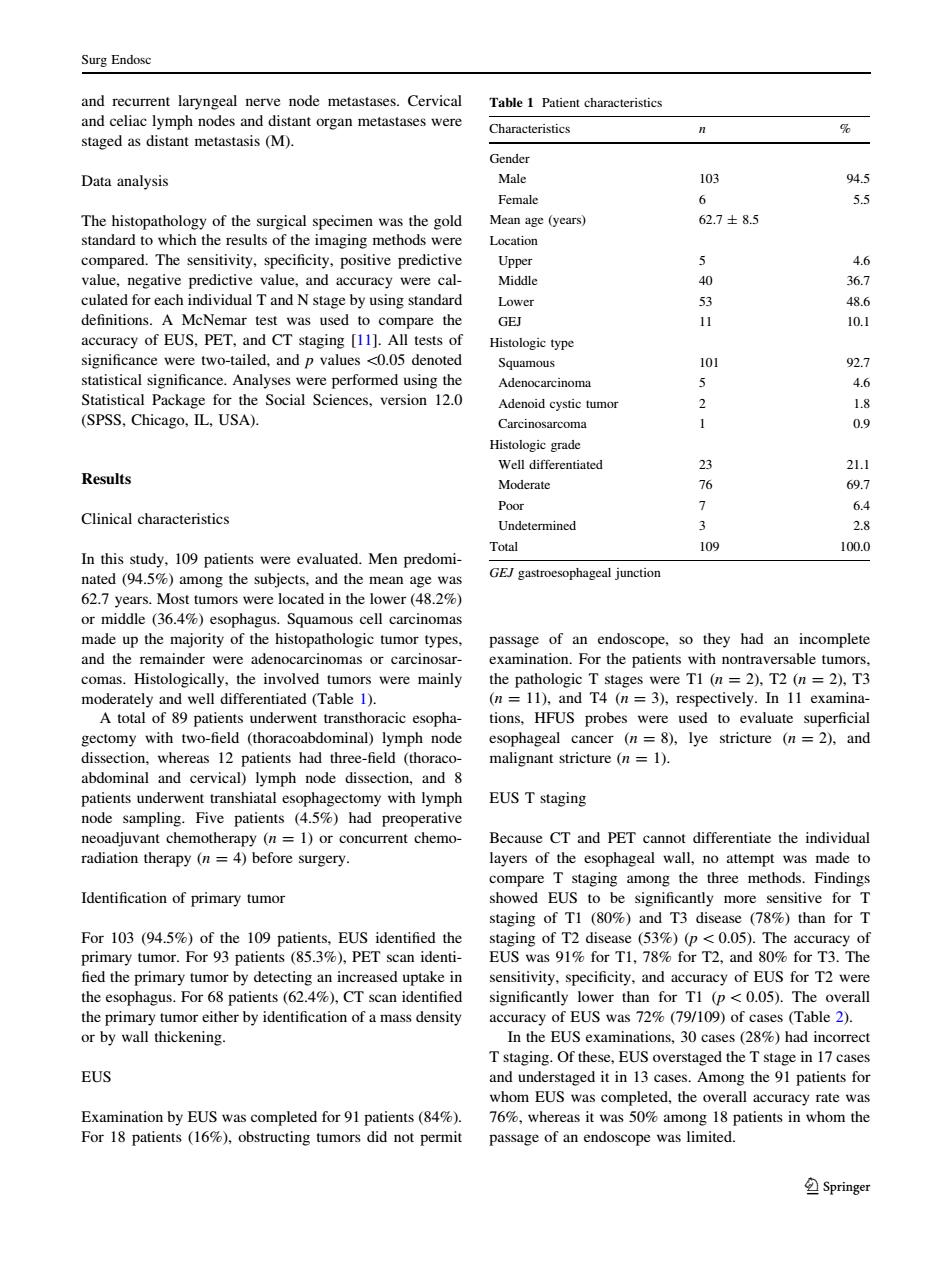正在加载图片...

Surg Endose and recurrent laryngeal nerve node metastases.Cervical Table 1 Patient characteristics and celiac lymph nodes and distant organ metastases were Characteristics staged as distant metastasis (M). nde Data analysis 103 945 e (years) 62.7±85 compared.The sensitivity,specificity.positive predictive 5 4.6 value,negative predictive value,and accuracy were cal- 36.7 culated for each individual T and N stage by using standard Lower 53 48.6 definition GEJ l01 tatistical significance.Analyses were performed using the Statistical Package for the Social Sciences.version 12.0 18 (SPSS.Chicago.IL.USA). 9 Well differentiad 21. Results Moderate 69.7 Poor Clinical characteristics Undetermined Total In this study,109 patients were evaluated.Men predomi- 109 100.0 GE/gastroesophageal junction of theh carcinomas or carcin comas.Histologically,the involved tumors were mainly the pathologic T sta ges were TI (n 2).T2 (n 2).T3 (n =11).and T4 (n=3).respectively.In 11 examina A total c racic esopha ons HFUS probes were used to evaluate gectomy with 1 node dissectio and 8 patients underwent esophagectomy with lymph EUS T staging node sampling.Five patients (4.5%)had preoperative neoadiuvant chemotherapy (n =1)or concurrent chemo- Because CT and PET cannot differentiate the individual radiation therapy (n =4)before surgery. layers of the esophageal wall,no attempt was made to thre meth Identification of primary tumor ofT1(80%) T3 (786) For 103(94.5%)of the 109 patients,EUS identified the ng of T2 disease (53%)(p<0.05).The a 0 primary tumor.For 93 patients(85.3%),PET scan identi- EUS was91%for T1,78%for T2.and 80%for T3.The fied the primary tumor by detecting an increased uptake in sensitivity,specincity,and accuracy of EUS for 12 were he esophagus.For 68 patients (o )CT scan identified significantl wer than P<0.05) accuracy Us was 729 109) able 2). ed the T stao in 17 case EUS and understaged it in 13 cases.Among the 91 patients for whom EUS was completed,the overall accuracy rate was Examination by EUS was completed for 91 patients(84%) 76%,whereas it was 50%among 18 patients in whom the For 18 patients (16%),obstructing tumors did not permit passage of an endoscope was limited and recurrent laryngeal nerve node metastases. Cervical and celiac lymph nodes and distant organ metastases were staged as distant metastasis (M). Data analysis The histopathology of the surgical specimen was the gold standard to which the results of the imaging methods were compared. The sensitivity, specificity, positive predictive value, negative predictive value, and accuracy were calculated for each individual T and N stage by using standard definitions. A McNemar test was used to compare the accuracy of EUS, PET, and CT staging [11]. All tests of significance were two-tailed, and p values \0.05 denoted statistical significance. Analyses were performed using the Statistical Package for the Social Sciences, version 12.0 (SPSS, Chicago, IL, USA). Results Clinical characteristics In this study, 109 patients were evaluated. Men predominated (94.5%) among the subjects, and the mean age was 62.7 years. Most tumors were located in the lower (48.2%) or middle (36.4%) esophagus. Squamous cell carcinomas made up the majority of the histopathologic tumor types, and the remainder were adenocarcinomas or carcinosarcomas. Histologically, the involved tumors were mainly moderately and well differentiated (Table 1). A total of 89 patients underwent transthoracic esophagectomy with two-field (thoracoabdominal) lymph node dissection, whereas 12 patients had three-field (thoracoabdominal and cervical) lymph node dissection, and 8 patients underwent transhiatal esophagectomy with lymph node sampling. Five patients (4.5%) had preoperative neoadjuvant chemotherapy (n = 1) or concurrent chemoradiation therapy (n = 4) before surgery. Identification of primary tumor For 103 (94.5%) of the 109 patients, EUS identified the primary tumor. For 93 patients (85.3%), PET scan identi- fied the primary tumor by detecting an increased uptake in the esophagus. For 68 patients (62.4%), CT scan identified the primary tumor either by identification of a mass density or by wall thickening. EUS Examination by EUS was completed for 91 patients (84%). For 18 patients (16%), obstructing tumors did not permit passage of an endoscope, so they had an incomplete examination. For the patients with nontraversable tumors, the pathologic T stages were T1 (n = 2), T2 (n = 2), T3 (n = 11), and T4 (n = 3), respectively. In 11 examinations, HFUS probes were used to evaluate superficial esophageal cancer (n = 8), lye stricture (n = 2), and malignant stricture (n = 1). EUS T staging Because CT and PET cannot differentiate the individual layers of the esophageal wall, no attempt was made to compare T staging among the three methods. Findings showed EUS to be significantly more sensitive for T staging of T1 (80%) and T3 disease (78%) than for T staging of T2 disease (53%) (p\0.05). The accuracy of EUS was 91% for T1, 78% for T2, and 80% for T3. The sensitivity, specificity, and accuracy of EUS for T2 were significantly lower than for T1 (p\0.05). The overall accuracy of EUS was 72% (79/109) of cases (Table 2). In the EUS examinations, 30 cases (28%) had incorrect T staging. Of these, EUS overstaged the T stage in 17 cases and understaged it in 13 cases. Among the 91 patients for whom EUS was completed, the overall accuracy rate was 76%, whereas it was 50% among 18 patients in whom the passage of an endoscope was limited. Table 1 Patient characteristics Characteristics n % Gender Male 103 94.5 Female 6 5.5 Mean age (years) 62.7 ± 8.5 Location Upper 5 4.6 Middle 40 36.7 Lower 53 48.6 GEJ 11 10.1 Histologic type Squamous 101 92.7 Adenocarcinoma 5 4.6 Adenoid cystic tumor 2 1.8 Carcinosarcoma 1 0.9 Histologic grade Well differentiated 23 21.1 Moderate 76 69.7 Poor 7 6.4 Undetermined 3 2.8 Total 109 100.0 GEJ gastroesophageal junction Surg Endosc 123